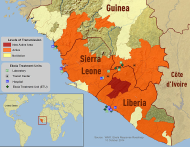
The Ebola Virus has killed nearly 5,000 people since a spike of West African infections in March of 2014, prompting the World Health Organization to declare an international public health emergency. Such an extreme public health crisis “requires an extraordinary response” to stop the spread of the disease, necessitating the mobilization of scores of medical organizations, hundreds of healthcare providers, and thousands healthcare workers. However, the response cannot truly be effective without a proper understanding of the data behind this epidemic. We have already seen the negative consequences of not applying data analysis techniques to this problem, with several cases of nurses exposed to the virus currently grabbing the attention of the media.
The Ebola response can be swift, safe, and thorough if we can properly harness the latest data analysis techniques. Praescient has explored tracking the spread of disease in the past, and many of the same principles in those cases apply to the current crisis. Learn about three of the best ways to use data to fight Ebola:
Understand the implications of low infection probability
With the proper precautions, the risk of infection for health care workers treating Ebola patients is relatively low. However, when these workers are continuously exposed to infected people, their own risk of infections increase proportionally. Brookings Institution nonresident senior fellow and Slate writer John Villasenor uses a comparison to describe how low infection probability can, over time, pose a high risk:
For example, consider an activity that, each time you do it, has a 1% chance of exposing you to a highly dangerous chemical. If you do it once, you have a 1% chance of exposure. If you do it twice, your chances of at least one exposure are slightly under 2%. After 20 times, you have an 18% chance of at least one exposure, and after 69 times the exposure probability crosses above 50%. After 250 times, the odds of exposure are about 92%. And the exposure odds top 99% after about 460 times. (from Slate)
Such insights are not always immediately obvious, but by using analytic methodologies, they can be incorporated into effective infection prevention protocols.
Derive insight from social and traditional media – from a worldwide lens
With all the proven success of using big data to attack problems, why couldn’t this Ebola outbreak have been predicted and acted upon well ahead of time? A lack of interconnectedness between global social and traditional media has emerged as a major reason for this missed opportunity. Harvard Health Map, a program spearheaded by researchers, epidemiologists, and software developers at Boston’s Children’s Hospital which “brings together disparate data sources to achieve a unified and comprehensive view of the current global state of infectious diseases,” was able to tap into the potential of global social networks to issue alerts about the outbreak 9 days before The World Health Organization. The Health Map team used blogs and social media posts written by the health care workers who first treated patients infected by the most recent outbreak to determine potential spread patterns.
While The Health Map’s efforts have proven to be an effective tool for early identification, it actually was not the first example of early detection with this outbreak. The Guinean government held a press conference on March 13th in which the director of the Division of Disease Prevention in the Department of Health “announced both the outbreak of the unknown hemorrhagic fever and the departure of a team of government medical personnel to the area to investigate it in more detail” (from Foreign Policy). This announcement was broadcast on Guinea’s national television and quickly appeared in national newspapers. The Health Map team and other organizations that examine similar big data did not detect this early warning because their collection methods focused primarily on English-language news sources and social media. By broadening the scope of big data collection and analysis to include global perspectives, we can more readily act on trends and patterns as soon as they are detected.
Crowdsource outbreak research, reporting, and response
As with many widespread, global challenges, leveraging the power of mobile technology is one of the best ways to learn about and to inform at risk populations. Using texts or apps allows researchers and responders to harness a powerful technological capability that is in the hands of many people the world over. A great example of this innovative approach can be found in an initiative started by the World Food Programme. This effort includes the sending of health text and Whatsapp alerts to the public and notifying aid programs of food security issues. Similar techniques were also used to conduct surveys of affected populations to determine the extent of the Ebola spread. “[An] advantage of mobile data collection is that is it quicker than sending around teams to do face to face surveys around the country,” said Jean-Martin Bauer, a WFP food security analyst (from the Daily Mail). With these dynamic, people-focused methods we can stay one step ahead of Ebola.
Praescient believes that data and analysis can be tools for social good. Armed with the right information and actionable insight, we can fight back against any global challenge.
Praescient Analytics is a Veteran-Owned Small Business that delivers training, data integration, platform customization, and embedded analytical services in partnership with leading technology providers. Praescient’s teams of analysts and engineers provide comprehensive solutions to federal and commercial clients engaged in critical defense, law enforcement, intelligence, cyber security, financial, investigative, and legal analytics missions.
Charlotte Stasio is Praescient’s Communications Specialist.